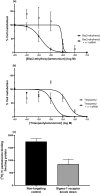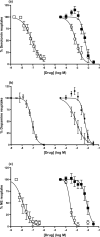Simple ammonium salts acting on sigma-1 receptors yield potential treatments for cancer and depression
- PMID: 32514120
- PMCID: PMC7280195
- DOI: 10.1038/s41598-020-65849-6
Simple ammonium salts acting on sigma-1 receptors yield potential treatments for cancer and depression
Abstract
Sigma-1 and sigma-2 receptors are emerging therapeutic targets. We have identified that simple ammonium salts bind to these receptors and are effective in vivo. Radioligand binding assays were used to obtain structure-activity relationships of these salts. MTS assays were performed to determine their effect on growth in MCF7 and MDA-MB-486 cells. Anticancer properties were tested in NMRI mice transplanted with a fragment of mouse adenocarcinoma (MAC13). Antidepressant activity was tested using the forced-swim test and tail suspension tests. Dipentylammonium (Ki 43 nM), tripentylammonium (Ki 15 nM) and trihexylammonium (Ki 9 nM) showed high affinity for the sigma-1 receptor. Dioctanoylammonium had the highest affinity (K50 0.05 nM); this also showed the highest affinity for sigma-2 receptors (Ki 13 nM). Dipentylammonium was found to have antidepressant activity in vivo. Branched-chain ammonium salts showed lower affinity. Bis(2-ethylhexyl)ammonium (K50 29 µM), triisopentylammonium (K50 196 µM) and dioctanoylammonium showed a low Hill slope, and fitted a 2-site binding model for the sigma-1 receptor. We propose this two-site binding can be used to biochemically define a sigma-1 receptor antagonist. Bis(2-ethylhexyl)ammonium and triisopentylammonium were able to inhibit the growth of tumours in vivo. Cheap, simple ammonium salts act as sigma-1 receptor agonists and antagonists in vivo and require further investigation.
Conflict of interest statement
The authors declare that the research was conducted in the absence of any relationships that could be construed as a potential conflict of interest. Author DRF is employed by Eli Lilly. Author K.K.A. is employed by Ultragenyx Pharmaceuticals Inc.
Figures







References
-
- Martin WR, et al. The effects of morphine- and nalorphine- like drugs in the nondependent and morphine-dependent chronic spinal dog. J Pharmacol Exp Ther. 1976;197:517–32. - PubMed
Publication types
MeSH terms
Substances
LinkOut - more resources
Full Text Sources
Medical
Research Materials
Miscellaneous

